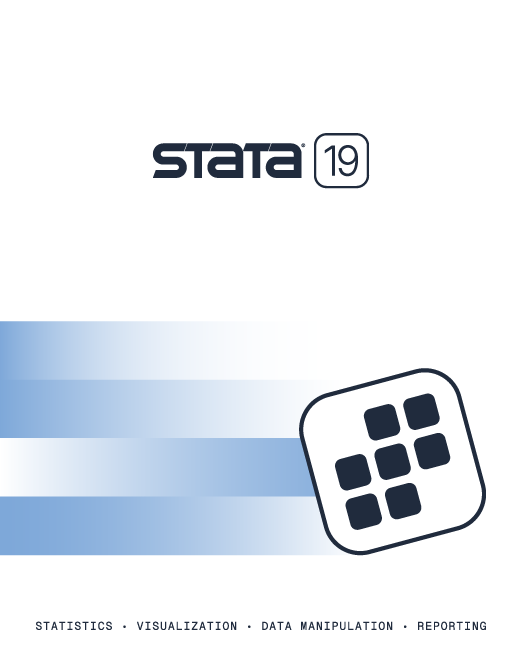The Italian Stata Users Group Meeting was held on 26 September 2019 at the Hotel Brunelleschi.
Proceedings
|
Abstract:
Stata 16 added some new features that could affect how users think of working
with Stata. Two of these features are frames and dynamic document extensions. I
will show the basics of using frames and explain how they can be exploited
for both space and speed. I'll also introduce the new dynamic document features
together with some example documents.
Additional information: italy19_Rising_slides.pdf italy19_Rising_handouts_a4.pdf italy19_Rising_handouts_us.pdf italy19_Rising.zip
Bill Rising
StataCorp
|
|
Abstract:
I present a model and a new Stata routine for estimating a latent (for example, non-observable)
network among N units (for example, individuals, companies, countries, etc.) using a set of units'
characteristics and without knowing any prior linkage among them. In this approach,
the units are represented via a set of indicators measuring a specific concept, such
as riskiness, knowledge, etc. A standard regression would be unsuited for estimating
the linkages because in this case the number of observations (the characteristics vector)
is much smaller than the number of variables (the units). The lasso regression allows
one to address high-dimensional settings like this one by allowing for an estimation of
a generally sparse matrix of linkages (the network). I will provide a Stata simulation
and possibly an application to real data.
Additional information: italy19_Cerulli.pdf
Giovanni Cerulli
IRCrES-CNR
|
|
Abstract:
We introduce the new stpreg command to fit flexible parametric models for the event-probability
function, a measure of occurrence of an event of interest over time. The event-probability
function is defined as the instantaneous probability of an event at a given
time point conditional on having survived until that point. Unlike the hazard function,
the event-probability function defines the instantaneous probability of the event. This
presentation describes its properties and interpretation along with convenient methods for
modeling the possible effect of covariates on it, including flexible proportional-odds
models and flexible power-probability models, which allow for censored and truncated
observations. We compare these with other popular methods and discuss the theoretical and
computational aspects of parameter estimation through a real data example.
Additional information: italy19_Bottai.pdf
Matteo Bottai
Andrea Discacciati
Giola Santoni
Karolinska Institutet
|
|
Abstract:
The original Stata command, xtarsim, simulates dynamic panel-data
models with exogenous regressors and i.i.d. errors. I
have now extended xtarsim in order to simulate models with
various types of endogenous or predetermined regressors.
This new version of xtarsim also allows MA(1) errors when
regressors are exogenous.
Additional information: italy19_Bruno.pdf
Giovanni Bruno
Università Commerciale Luigi Bocconi
|
|
Abstract:
Dynamic stochastic general equilibrium (DSGE) models are
used in macroeconomics for policy analysis and forecasting.
A DSGE model consists of a system of equations (usually a
nonlinear system of equations) that is derived from economic
theory. This presentation illustrates how to easily solve,
fit, and analyze nonlinear DSGE models. I will explore how
to obtain policy matrices, transition matrices, and impulse–response
functions for nonlinear models.
Additional information: italy19_Schenck.pdf
David Schenck
StataCorp
|
|
Abstract:
In this presentation, we describe a new Stata command, zonotope,
that, by resorting to a geometry-based approach, enables
one to provide a measure of productivity that fully accounts
for the existing heterogeneity across firms within the same
industry. Further, the method that we propose also enables
one to assess the extent of multidimensional heterogeneity
with applications to production analysis and productivity
measurement. Finally, we detail the functioning of Stata
to perform the related empirical analysis, and we discuss the
main computational issues encountered in its development.
Additional information: italy19_Cococcioni.pdf
Marco Cococcioni
Università degli Studi di Pisa
Marco Grazzi
Università Cattolica del Sacro Cuore
Le Li
Chuo University
|
|
Abstract:
The python package facilitates integrating Python with
Stata 16 by allowing automatic interprocess communication
between the two software packages. Here I present a
statistical application implemented in Python and called in
Stata for discerning and quantifying power law behavior in
empirical data.
Additional information: italy19_Zinilli.pdf
Antonio Zinilli
IRCrES-CNR
|
|
Abstract:
During the last two decades, a growing interest in
understanding what determines the redistributive role of
tax-benefit systems has been recorded worldwide. For the
case of Italy, the previous analyses were mainly focused on
quantifying the contribution of marginal tax rates, deductions,
and tax credits to the redistributive capacity of PIT, neglecting
the effect on income redistribution of proportional taxes and
income sources exempt from taxation such as tax-free cash
benefits. The following presentation aims to fill this gap by applying
two alternative Gini-based decomposition methodologies
(Onrubia et al. 2014; Urban 2014) to the Italian tax-benefit
system's redistributive power over the period 2005–2018. The
contribution of each tax-benefit instrument is quantified for
several baseline policy scenarios that diverge from each
other for being representative of different degrees of extension
of the tax-benefit system under study.
Additional information: italy19_Boscolo.pdf
Stefano Boscolo
Università degli Studi di Modena e Reggio Emilia
|
|
Abstract:
Older people are often affected by several comorbid
conditions and by an increasing risk of death that rises with
aging. Previous studies examining the association of cancer
with dementia in older adults have usually used standard
approaches without accounting for the competing risk
of mortality. However, ignoring mortality may not provide valid
estimates of risk of dementia, because cancer is strongly
associated with the competing risk of death. This
study considers people over 72 years old from two Swedish
population-based longitudinal studies: The Kungsholmen
Project (KP) and the Swedish National Study on Aging and
Care project conducted in the Kungsholmen district of the
city of Stockholm (SNAC-K project). The aim of the study is
to analyze the association between cancer and the onset of
dementia in the considered older population. The competing-risk
methodology is used to illustrate the appropriate statistical
methods for competing risks, their correct application, and
interpretation of the results, having death as the competing
event.
Additional information: italy19_Damiano.pdf
Cecilia Damiano
Rino Bellocco
Università degli Studi di Milano-Bicocca
|
|
Abstract:
In this presentation, I will attempt to demystify the field of
machine learning and compare it with traditional statistical
approaches in economics and social sciences. I discuss
relative strengths and weaknesses and how machine
learning can facilitate causal inference. This presentation serves as
a preamble to the one-day workshop that will happen the following day.
Additional information: italy19_Ahrens.pdf
Achim Ahrens
ETH Zürich
|
|
Abstract:
Stata developers present will carefully and cautiously
consider wishes and grumbles from Stata users in the audience.
Questions, and possibly answers, may concern reports of
present bugs and limitations or requests for new features in
future releases of the software.
StataCorp personnel
StataCorp
|
Scientific committee
Una-Louise Bell
TStat S.r.l.
Rino Bellocco
Università degli Studi di Milano—Bicocca
Giovanni Capelli
Università degli Studi di Cassino
Maurizio Pisati
Università degli Studi di Milano—Bicocca
Logistics organizer

The logistics organizer for the 2019 Italian Stata Users Group meeting is TStat S.r.l., the distributor of Stata in Italy.
View the proceedings of previous Stata Users Group meetings.






